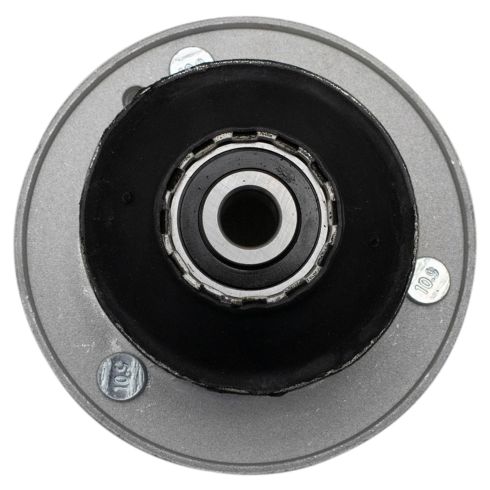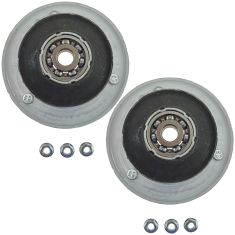What's up, guys? I'm Andy from 1A Auto. In this video I'm going to show you how to replace the front strut mounts on this 2001 BMW 325xi. If you need this part or other parts for your vehicle, click the link in the description and head over to 1AAuto.com.
I raised the vehicle. We're using a two-post lift if you're doing this at your house. You can use a jack and jack stands. I'm going to remove tire to gain extra access. It's going to make it a little bit easier. I'm going to use a 17 millimeter socket and an air gun. You could always use a breaker bar. Take these lug nuts out, or lug studs out. When I get to the last one, I'm just going to hold the wheel so it doesn't fall. Take the last one out. Grab the wheel, pull it off.
I'm going to loosen up this nut on the link right here. I'm just going to spray some rust penetrant on the nut just to help loosen it up. I'll take a 16 millimeter socket and a ratchet and then I'm going to loosen it first and I'm going to switch to a wrench. I just turned the wheel a little bit to gain access to this nut so that I can use a 16 millimeter wrench on the nut and I'm going to hold the stud with a T27 socket and a ratchet. Check to see if a T30 fits. This one may be rusted and that's why it's a T27, but this one fits. That'll hold the stud. After a while, I was able to get the T30 on the stud. I think it was just rusted, that's why it wouldn't go on originally. Loosened up that nut. Take that off there. Take the nut off, then you can slide the stud out.
Just going to spray some rust penetrant on this bolt. It's pretty rusty. Right there, let it soak for a little bit and just take an 18 millimeter socket and breaker bar, loosen this bolt up. Going to switch to a ratchet or if you have an air tool, you can use an air gun. Take this bolt out. Take that bolt out and there's a bracket right here. We're just going to set that bracket aside. The brake hose goes through the bracket and the ABS wire. All right, move that aside.
You want to take some kind of punch because we want to move this spindle down or the knuckle down. We're going to place it right here and you can take a pretty heavy hammer. We're going to tap it down. As you can see, the strut is staying stationary and the knuckle is going down. At this point it's pretty loose, I can just wiggle it back and forth, slide this down, slide this out of the way. Be careful with the driveshaft, well, the front CV shaft. You don't want to have that get pulled out or anything. Just slide that to the side. Just make sure that stays like that. Should be okay.
I am going to take a bungee cord, just hook onto here and hook around the lower control arm. I'm just trying to prevent this whole thing from sliding out. Just hook that there, and hook this over here. That should be good. Then it's not going to pop the CV boot out or anything.
All right, now I'm going to take these three nuts off. I'm going to use a 13 millimeter socket and a ratchet. Be careful not to arc out your ratchet on this stud right here. There should be a cover on here. This vehicle does not have one, so take these off. All right, from underneath, I'm actually going to grab the strut itself and from on top, I'll just take out this last nut and just use a gun. You can use an air gun. Loosen it up and take it out. Just slide it down and slide it out.
We're going to take that strut assembly and put it into a strut compressor machine. They do make different home devices that you can use to compress the spring. Just be careful. With this in here, I'm going to take a straight blade screwdriver and just pop this cap off right there. I can access the nut. I'm going to compress the spring. I'm just compressing the strut, rechecking it, just making sure once the strut is loose, then I'm able to loosen up the nut. Just being very careful.
There's actually a tool to remove this nut from the strut mount so that you can get the strut out and take the mount off. It would be like a 21 millimeter socket with a long handle on it and then you can use a hex socket or a hex bit to hold the shaft from spinning, but we don't have that so what I'm going to do is take some locking pliers and I know this is not recommended, but we're going to be high up on the shaft so it's never going to reach down below there. I'm going to lock onto the shaft. Now why they don't want you to use locking pliers is because if it mars up the shaft at all, if the shift goes down to where the seal is, it's going to mess up the seal. The shaft is never going to get compressed into the strut assembly that deep.
With my locking pliers there, I'm going to take my 21 millimeter socket and an air gun, take off the nut. Be careful, the strut is probably going to fall and hit the ground. Actually, I have the locking pliers holding it, so it won't. Take the nut off and slide the mount off. There's the bottom part of the bearing, set that aside. Now grab the strut and loosen up the locking pliers. Pull that out. Here's the old part. Here's the new strut mount from 1AAuto.com. Has the bearing in the middle, same as the old one. Has the same stud configuration. Has this little index tab. Comes with new nuts. Get yours at 1AAuto.com and you can do it yourself.
Carefully, slide the strut back into the spring. Get that lined up. Take the new mount. There is a washer at the base of this, leave that washer there. Put the new mount on. Take the new nut. If you had the proper tool, this is then you would want to tighten this down. The proper tools looks something like this. This happens to be an O2 sensor socket. What that would do is go on the nut right there, then you could take the hex bit, this happens to be a seven millimeter hex bit on a socket, and you could hold that like that and then use your torque wrench and tighten down the bolt ... I mean the nut.
Since we don't have that specific tool, what I'm going to do is use some locking pliers. Again, this isn't recommended, but this is the best we can do. We're going to grab the top part of the shaft, that way, at the top part of the shaft, it's not going to hit the seal at all. There's no way it could compress that much. It's not that big of a deal. Then I'm going to take a socket. It seems like the new nut that comes with the strut seems more like a 7/8 socket versus a 21 or a 13/16. Then I'm going to hold the locking pliers and tighten this nut to 47 foot pounds. There we go, we're already there.
Now I can take the locking pliers off. Just like I said before, make sure when you grab onto the shaft, it's really high up. You don't want to grab it down low. You can put this cover on. All right, so we want to make sure the spring is lined up properly down below, pretty much the way it came out. Then loosen up on this compressor. Just be careful when doing this type of job. A lot of times the springs can do some crazy things. It's pretty dangerous. Slide those out, and there we go. Now we can install it in the car.
With the strut, I want this little tab right here facing towards the vehicle and there's this little index tab that's going to line up right there. Slide this in from underneath just like that. Get the studs to go through and I'll take these nuts, I'm going to get these all started. You can kind of see where you want to tighten this down kind of where it was before. Then when you go to have an alignment done, it'll be closer. It's a good idea to have an alignment done after you do this repair to make sure your tires don't get burned out going down the road.
All right, I am going to leave these two nuts a little bit loose first because I want to slide this into position before we tighten those up. This little tab is going to go through that groove. Spin that in the proper location. Push that like that. Just wiggle that a little bit. With that lined up, I'm just going to take a floor jack and get underneath the control arm, right under the ball joint. Actually take that off, and start pressing up on that. Make sure it goes in there correctly. Just wiggle it back and forth a little bit. I'm just pushing, just using the floor jack put a little bit a pressure, pushing up. Just be careful with your fingers, don't get anything caught.
Our strut has bottomed out on our knuckle, which is good, so I'm going to take the bolt, it's probably a good idea to get a replacement bolt for this. Make sure you take this bracket, line the bracket up and slide the bolt in. If you can't the bolt into this position, then your strut's probably not all the way down or it's twisted, but there is that guide pin that should line up with that channel, so you should be all set.
Just going to take an 18 millimeter socket and ratchet, and just tighten this down first. Going to take my 18 millimeter socket and a torque wrench, I'm going to torque this bolt to 74 foot pounds. All right, that's good. Now I'm going to tighten these upper nuts down. Now with these nuts tightened down, I'm just going to use a 12 millimeter socket and a torque wrench, I'm going to tighten these to 21 foot pounds. With the strut all tightened in there, I can lower the floor jack. At this point, you can remove the bungee cord. Take that off
The sway bar link, slide that in position. Take a 14 millimeter wrench, put it on the backside on the stud, and get the nut started. Take your 15 millimeter socket and ratchet, tighten this up. Then use the torque wrench and torque this nut to 47 foot pounds. Now I'm going to put the wheel on, just line up the holes. Take one of the lug studs, get that started. I can grab the other ones. I'll just tighten these down and then I'm going to lower the vehicle and torque them.
All right, now I'm going to use a 17 millimeter socket and a torque wrench. I'm going to torque these lug bolts to 95 foot pounds. I'm going to torque them in a start pattern so that the wheel gets tightened down evenly. Then I'm just going to go around again, just double check. Good to go.
Thanks for watching. Visit 1AAuto.com. Your place for DIY auto repairs, for great parts, great service, and more content.










